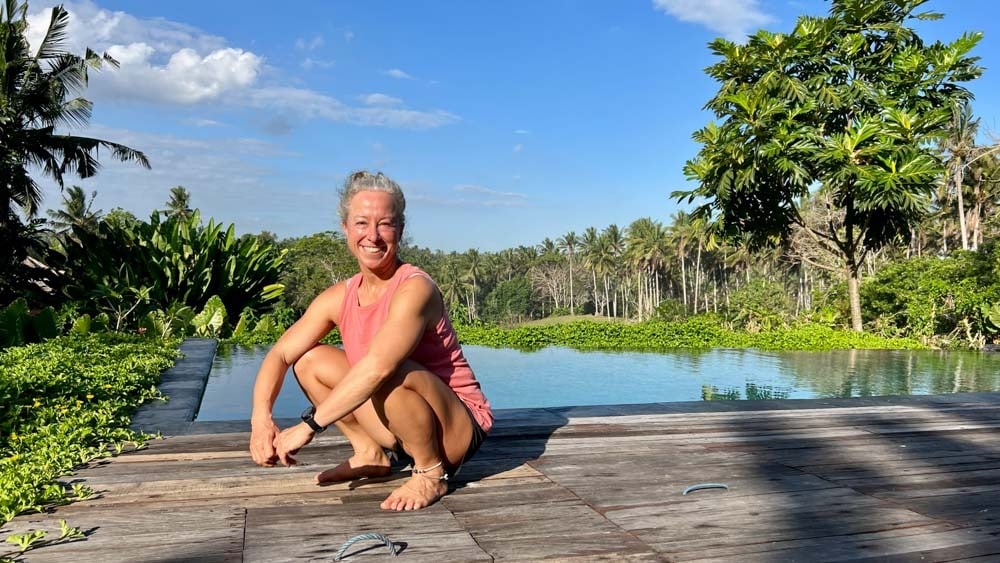Squatting is a natural movement pattern that has almost gone extinct in the modern, chair sitting, shoe wearing world.
I’m not talking about the gym squat – the loaded weight training squat seems to be a staple of body building to this day.
Nope, I’m talking about the dynamic human squatting patterns used by our hunter gatherer ancestors as a resting position, a base from which to harvest roots & leaves, and an essential bathrooming option. Sometimes called an ‘Asian’ squat because there are still many cultures in Asia where squatting is still commonplace (and done at every age).
Although toddlers of all cultures can squat (perfectly), Westernized humans typically lose their squat shortly after starting school. No surprise, since schools enforce long hours of chair time!
Once our bodies are adapted to not squatting, this essential human movement pattern becomes impossible. Instead of a comfortable deep squat, we fall backwards, our heels lift, our feet & knees have to point out super wide, or our knees hurt too much. So most of us simply stop.
This is a shame, because squatting can contribute both to our health and to our experience of the world around us. But the good news is that with some practice and a bit of strategy, most of us can restore our squat. Even the process of working on our squat delivers many wellness benefits.
So even if you never get a full, relaxed resting squat, the journey itself is worth your time! Before I show you how to start squatting – let’s talk about why squatting is so important!
Why You Should Start Squatting
For me, the biggest reason to squat is simply that humans are squatting animals. We evolved with squatting, which means that many systems of our body evolved in a squatting environment and therefore depend on squatting patterns for the movement inputs they provide.
In other words, squatting is a key movement nutrient, and it’s one that most of us are missing. Since squatting is a full body movement pattern, I’d speculate that squatting impacts – at a minimum – the health of our ankles, knees, hips, pelvic floors, spines, digestive systems and our metabolic health.
Here’s some specifics on why I think squatting is really great for our bodies:
1️⃣ Squatting moves our ankles, knees & hips through their fullest ranges of motion. Joints LOVE moving – movement is what maintains & even improves joint health. Joints that never move through their full range of motion eventually lose their range and capacity. So squatting is one real life way to maintain and improve joint health.
2️⃣ Squatting demands upper back extension – this helps us stay balanced instead of falling backwards. This movement is the opposite of the hunching forward movement we use to engage with our phones & keyboards, so it’s a great idea to get a regular dose of it!
3️⃣ Squatting uses our glutes & hamstrings – big posterior chain muscles that help keep our pelvic floors, hips & knees happy. Plus muscle mass is important – especially as we age. It’s just a great idea to have more muscle! So, a movement pattern like squatting that uses big, chunky muscles is one we need to do more!
4️⃣ Squatting as a resting position uses more lower limb muscle activity than sitting. In other words, when we’re squatting, our bodies are using our muscles for support, not the seat of a sofa. It seems likely that this contributes to better cardiovascular health.
5️⃣ The way our glutes contract in squatting seems to balance loads on our pelvic floor muscles by providing a ‘backwards’ pull instead of the ‘forwards’ pull that we’re familiar with from Kegels.
Maybe the best reasons to squat, though, have nothing to do with our physical health. Squatting is simply a wonderful way to interact with our world. Squatting to play with your grandkids brings you into their world. Squatting gets you closer to flowers, roots & weeds in the garden. And squatting helps you go backpacking in comfort, no need to bring a chair! It’s a movement that’s about experiencing life in an intimate and functional way!

But can deep squats damage your knees?! This seems to be a discredited theory based on poor original research. To me, the fact that older adults in squatting cultures can squat no problem supports the argument that deep squats are not damaging and can in fact be very beneficial for our bodies.
But (especially if you haven’t done a full squat since you were about 5 years old) I definitely think it’s a good idea to be careful and gentle when you start squatting again, particularly if your knees are currently unhappy. It’s all about gradually coaxing your body into a squat so you can rebuild your capacity – not forcing anything or overloading yourself!
Why You Shouldn’t Start Squatting (Yet)
Squatting requires specific types of strength, mobility & stability. If you haven’t squatted for a really long time (such as since you were 5 years old), you’re likely missing out on any or all of what you need in order to squat without discomfort or compensatory movement.
As well as doing gentle whole body squat variations like the kitchen sink squat, you should work on the building blocks of your squat in order to hone in on your particular needs. This will help you avoid injuries, and will actually mean you progress faster towards a full resting squat – because you won’t just be practicing compensations. Plus you’ll enjoy more of the health benefits of squatting along the way.
What’s a compensation? When our bodies don’t have access to a movement prerequisite, they’ll usually figure out a way to ‘kinda’ get there. These compensations help us get life done – but they’re not usually as efficient or healthy as the optimal pattern would be. For example in a squat, if you lack hip flexion mobility, your low back will usually round instead. This means your hips miss out and your low back does extra. It’s not exactly wrong to access compensatory movement patterns, but in the long term, it’s usually better to have access to the original patterns as well.
How To Start Squatting
“There is a difference between saying, “It is natural behavior for a human to squat multiple times a day throughout their lifetime,” and, “You need to start squatting ten times a day, starting now.”
Katy Bowman, Move Your DNA
The truth is, there are lots of ways to coax back your squat!
But to keep things simple, I think you should start by practicing my favourite whole body squat prep exercise – the Kitchen Sink Squat.
This gentle squat variation will help you build your strength & capacity and work on your technique – and it’s totally modifiable so it should work for almost every body.
But most importantly, you can do it every time you’re at the kitchen sink – so you can get lots of practice. And when it comes to movement, frequent practice is going to help you make the most changes.
Watch this quick video and start squatting TODAY!!
If that’s how you can start squatting – what’s next?
Now things get a bit more complicated.
The 7 Main Barriers To Your Squat
Although every body is unique, most people will find that limitations in one or more of the following areas are what’s getting in the way of their squat. It’s a really good idea to work specifically on each part of your squat individually – before or as well as practicing full squat variations.
Here’s what to think about:
Ankle mobility
Because many people notice their heels spring up when they try to squat, ankle dorsiflexion mobility is often seen as the main barrier to squatting.
I don’t entirely agree with this – sometimes our heels pop up because our hips or hamstrings are tight. And especially for people with shorter femurs like myself, a resting squat may not require much ankle mobility.
However, some ankle dorsiflexion is definitely a pre-requisite for squatting and especially for tall people with long leg bones, this can be worth working on (here’s a link to a YouTube class I made to help you improve your ankle joint mobility).

Knee mobility
If your knees don’t like to flex all the way, a deep squat may be tough for you (a full resting squat requires extreme knee flexion – around 130-140 degrees).
You may be limited because the muscles around your knee don’t yield, or because of something going on in the joint itself, such as an injury, swelling or arthritis.
Most people can improve knee flexion mobility with a combination of stretching (try the gentle quad stretch in this video) and mobility work such as the knee CARs I teach in my Joints For Life program.
This includes people with knee replacements, which can often reach an impressive range of motion when correctly rehabbed! Of course, check with your doctor if you have an injury or a replacement to find out whether there’s any movement that’s specifically contraindicated for your body – but working in a pain free range to improve strength & mobility is almost always a great idea!

Hip mobility
Limited hip mobility is a huge issue for many people. Our hips are great at bending to about 90 degrees – the same angle we use when we sit in a chair. But ask for more than that, and the movement often ends up coming from our lower back.
Like knee & ankle mobility, it’s possible to make huge improvements in hip mobility with some time & practice. Hip CARs (from my Joints For Life program) are a great starting point.
One key to building hip mobility is learning how to isolate the movement at your hips. This is essential to reduce the amount we use our spines to compensate for hip movement, and allows us to get more change from our actual hips. This means that learning to hip hinge correctly is another key to restoring your squat – check out this video and then start practicing!
Posterior chain suppleness
For a great squat, you need to be able to stick your butt out. A ‘butt out’ squat uses more glutes & hamstrings and less quads. And this helps lengthen & strengthen your pelvic floor. Added bonus – a ‘butt out’ squat is a lot easier on sore knees!
But tight hamstring muscles on the back of your body can make a ‘butt out’ squat tough! So many of us need to work on hamstring length as a key to better squatting. Bonus – this can help with the ankle mobility piece as well. The hip hinge I mentioned above is a great way to work on your hamstrings as well as your hip mobility so definitely make sure you check it out!
Upper back mobility
I know it seems a bit weird to work on your spine so you can squat, but the truth is, our upper back has a lot to do with our ability to stay upright & not fall backwards as we squat.
It’s all about your centre of gravity – if your spine is curved forward too much (especially if your hip mobility is limited) you’re going to have to hold a lot of your body weight behind your feet. So much so that sometimes it will literally make you fall back!
Improving your spinal mobility is generally one of the better things you can do for your body. It pays off for your breathing, your core strength, your pelvic floor health and of course, for your spine – so you get a lot of wins on this one! Try this class to work on your upper back for squatting – especially the third exercise!
Strength & control
Even if you don’t have a full range of motion squat, you can still build strength & control simply by making your squats smaller or less loaded.
Doing ‘mini squats’ where you don’t go down all the way will help you build strength, control & stability within your existing capacity. By working in the range you can manage, you’ll naturally expand your ranges of motion, build your muscles and improve your resilience.
Here’s a few ways to do a modified squat (plus some extra ideas!).
Some Extra Considerations
Of course, there are other barriers to a full resting squat.
Some people find that carrying extra weight on their mid-section makes squatting difficult (try putting your feet and knees wider to give yourself more room).
Some people (like me!) tend to put a lot more weight on one foot than the other, so their squat is very asymmetrical (try squatting in front of a mirror or a video camera to adjust your position, or work on your stability & movement patterns like I teach in my Pelvic Floor + program).
Some people find that squatting gives them pins and needles or makes their shins burn if they hold the position for a long time (the answer here is usually to move more often, and to spend more time in less loaded squat-like positions).
Or you may have a prolapse, and be concerned about putting pressure on your pelvic floor when squatting (you need to learn how to manage your breathing & core pressure, and would do well to practice squatting with zero loads until you’ve got the hang of that. You can find all that and more in my Pelvic Floor + program).
I’m sure there are some other challenges I haven’t mentioned, too!
For most barriers, however, the answer is to explore different positions, lighter loads, and using support until you find the squat that you CAN do. Then, you practice & build.

Next Steps
Ok, I know that’s a lot. Squatting is a whole body movement pattern, it’s not going to get restored instantly or the same way for everyone. But it’s definitely possible – it’s just about time, practice, and sticking with it. And of course the great news is that working on each part is amazing for your movement health!
So if you’re eager for more, you’ll be happy to know that I have some really exciting next steps to help you on your squatting journey!
I’m officially inviting you to join my Start Squatting Challenge – a (totally free) movement challenge designed to help you improve your squatting capacity and nurture your wellness at the same time!
Every week for one month I’ll send you a new whole body squat variation to practice (don’t worry, they’ll be gentle & safe). All you need to do is click here to get the details & join the fun!






